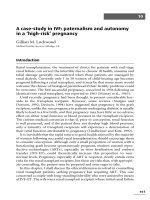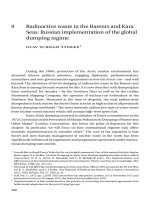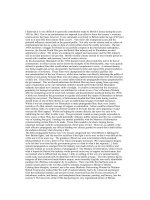in rivers lakes and ponds
Bạn đang xem bản rút gọn của tài liệu. Xem và tải ngay bản đầy đủ của tài liệu tại đây (7.3 MB, 33 trang )
Sabrina Crewe
Consultant:
Professor Anne K. Camper,
Montana State University
Under the Microscope
In Rivers,
Lakes, and Ponds
Copyright © 2010 by Infobase Publishing
All rights reserved. No part of this book may be reproduced or utilized in any form or by any means,
electronic or mechanical, including photocopying, recording, or by any information storage or retrieval
systems, without permission in writing from the publisher. For information contact:
Chelsea Clubhouse
An imprint of Chelsea House
132 West 31st Street
New York NY 10001
Library of Congress Cataloging-in-Publication Data
Crewe, Sabrina.
In rivers, lakes, and ponds / Sabrina Crewe ; consultant, Professor Anne K. Camper.
p. cm. (Under the microscope)
Includes index.
ISBN 978-1-60413-826-9 (hardcover)
ISBN 978-1-4381-3368-3 (e-book)
1. Freshwater microbiology Juvenile literature. 2. Microscopy Juvenile literature. I. Title. II. Series.
QR105.5.C74 2010
502.8’2 dc22
2009050499
Chelsea Clubhouse books are available at special discounts when purchased in bulk quantities for
businesses, associations, institutions, or sales promotions. Please call our Special Sales Department
in New York at (212) 967-8800 or (800) 322-8755.
You can find Chelsea Clubhouse on the World Wide Web at
Text design by Sabine Beaupré
Illustrations by Stefan Chabluk
Originated by Discovery Books
Composition by Discovery Books
Cover printed by Bang Printing, Brainerd, MN
Book printed and bound by Bang Printing, Brainerd, MN
Date printed: May 2010
Printed in the United States of America
10 9 8 7 6 5 4 3 2 1
This book is printed on acid-free paper.
All links and Web addresses were checked and verified to be correct at the time of publication.
Because of the dynamic nature of the Web, some addresses and links may have changed since
publication and may no longer be valid.
Acknowledgments
We would like to thank the following for permission to reproduce photographs: Dennis Kunkel Microscopy, Inc.:
pp. 15, 17, 21 top; National Park Service: p. 26; Science Photo Library: pp. 5 (Stefanie Reichelt), 6 (Eric Grave),
8 (M. I. Walker), 9 (Eye of Science), 10 (Power and Syred), 11 (Gerd Guenther), 13 bottom (M. I. Walker), 14 (Jan
Hinsch), 16 (Kent Wood), 18 (Sinclair Stammers), 19 (John Walsh), 20 (M. I. Walker), 22 (Martin Dohrn), 23 (Gary
Meszaros), 24 (David M. Phillips), 25 top (Michael Abbey), 27 bottom (Eye of Science); Shutterstock Images:
pp. 4 (Yurchyks), 13 top (Christopher Meade), 21 bottom (Jubal Harshaw), 25 bottom (Hagit Berkovich), 27 top
(Marco Regalia), 29 top (Devon Sarian), 29 bottom (Anthony Harris); US Department of Agriculture: p. 12.
Contents
Watery World 4
Protists 6
Ciliates 8
Amoebas 10
Algae 12
Diatoms 14
Microanimals 16
Rotifers 18
Crustaceans 20
From Water to Air 22
Bacteria and Cyanobacteria 24
Extreme Lifestyles 26
Size and Scale 28
About Microscopes 28
Micro-Detective 29
Glossary 30
Explore These Web Sites 31
Index 32
Some words are bold the first time they appear
in the text. These words are explained in the
glossary at the back of this book.
4
4
Watery World
We may live on land, but there is water all around
us. Somewhere near your home, there is a pond or
a stream, a river or a lake.
Microscopic life
Wherever there is water, there is a tiny world of living
things, or organisms. Organisms too small for us to
see are called microorganisms. If they were your
size, you would think they were alien beings
from another planet. But some are so small that
thousands of them can fit into a drop of water!
5
5
Micro-Monster
This is the head of
a Polyphemus water
flea. The Polyphemus
has one giant eye
(bottom left) that it
uses to find its prey.
In real life, the whole
flea is only about
1 millimeter across,
or about the length of
this line .
Many different kinds of microorganisms live in
water. They can be animals, plants, or something in
between. To visit this miniature watery world, we need
a microscope. The microscope will reveal creatures
that you never knew existed.
Above and below
We’re going to look in ponds and lakes, where the
water is still and microorganisms live on or near the
surface. We are also going to see creatures that live at
the bottom of rivers and streams, clinging to rocks or
plants as the water rushes over them.
6
6
Protists
Many water-dwelling
microorganisms belong
to a group of organisms
called protists. Protists
aren’t plants or animals.
Some—known as
protozoa—behave like
animals. Others—often
called algae—are more
like plants. Most protists,
whether they are protozoa
or algae, have only one
cell. But even with just
one cell, they can make
or capture food, move
around, and reproduce.
Protozoa
Some protozoa are
flagellates, which means
they have long strands
on their bodies that they
beat back and forth to
move around. Others
are ciliates—they have
cilia, or hairs, to propel
them along. Amoebas
are slow-moving blobs
Actinopods are
a type of protozoa. They
are also sometimes called
“sun animalcules” because
their axopods, or thin limbs,
look like rays of the Sun.
Actinopods use these
axopods to catch
their prey.
6
Protists
Many water-dwelling
microorganisms belong
to a group of organisms
called protists. Protists
aren’t plants or animals.
Some—known as
protozoa—behave like
animals. Others—often
called algae—are more
like plants. Most protists,
whether they are protozoa
or algae, have only one
cell. But even with just
one cell, they can make
or capture food, move
around, and reproduce.
Protozoa
Some protozoa are
flagellates, which means
they have long strands
on their bodies that they
beat back and forth to
move around. Others
are ciliates—they have
cilia, or hairs, to propel
them along. Amoebas
are slow-moving blobs
of protozoa, but they
can capture and eat
other creatures living
in the water, including
microanimals.
Plant-like
protists
Algae, or plant-like
protists, are similar to
plants because they
make their own food
through the process
of photosynthesis. As
you will see, many of
them don’t resemble
plants that grow on
land. Diatoms, for
example, look
like shiny disks
or sticks.
We’re going
to take a look at
several types of
protists that you
might find under a
microscope in rivers,
lakes, and ponds.
Domains of Life
Biologists often divide living
things on Earth into three
domains, which are shown
below. Eukaryota are living
things with a certain kind of cell
called a eukaryotic cell. These
cells are quite complex and
ordered, with a nucleus and
other separate parts. Protists,
plants, animals, and fungi
are all part of the eukaryotic
domain. The other domains are
those of bacteria and archaea.
(We’ll be looking at them later.)
These organisms have simpler
cells called prokaryotic cells.
BACTERIA
EUKARYOTA
ARCHAEA
Chromists
(similar to protists)
Plants
Animals
Fungi
Cyanobacteria
Dinoflagellates
(protists)
Flagellates
(protists)
Other protists
Other
bacteria
Salt-loving
microbes
Heat-loving
microbes
Red algae
(protists)
7
8
Ciliates
Ciliates are protozoa,
or animal-like protists.
There are thousands
of different types of
ciliates. What they
have in common are
the tiny hairs called
cilia that grow from
their bodies. They use
their cilia like oars
in the water to move
around and to stop.
Many ciliates
are shaped like
fish, which makes
them a good shape
for moving quickly
through the water.
Other ciliates live
attached to an object,
such as a river plant
or a rock. Whether
they are free to swim
around or stuck in
one place, ciliates
feed by catching
and eating other
microorganisms.
8
Some ciliates,
called peritrichs, have
cilia that form fringes
around their mouths. The cilia
create currents that bring
food particles toward them.
Peritrichs usually live in
colonies, or groups,
attached to a surface
by long stalks.
Swimming
around
The Paramecium is
a ciliate that swims
near the surface of
ponds, lakes, and
rivers. It shoots
out sharp-tipped
threads, like darts,
to attach itself to
a surface while
it eats its prey. It
also has poisonous
darts to fire at other
creatures that try to
prey on it!
Staying put
Suctoria are a type
of ciliate that live
attached by a stalk
to algae or other
things. They reach
out for prey with
their tentacles,
which have sticky
pads on the ends.
When they catch
something to eat,
suctoria suck out
their prey’s insides!
9
Micro-Scientist
Scientists who study
animals are called zoologists.
Protozoologists study everything
to do with protozoa. They
may focus on protozoa that
get into drinking water and
make people sick.
Micro-Monster
Some ciliates, such as the Didinium
(below left), can swallow prey bigger
than themselves. The Didinium is
engulfing a Paramecium (right).
10
Amoebas
The body of an amoeba is a little like a blob of jelly.
But don’t be deceived: these slow-
moving protozoa can catch prey
just as well as any animal.
Stalking prey
Amoebas live and hunt
for food at the bottom of
lakes and ponds. They
have little branches
on their bodies, called
false feet, which they
extend to explore with.
How Small
Is Small?
The biggest species of
amoeba are up to 5 millimeters
across, so you could see them
without a microscope. The
smallest are smaller than
10 micrometers, and there
are 1,000 micrometers
in a millimeter.
The amoeba
on the left is
extending its false
feet to capture
another amoeba.
These amoebas have
been magnified
230 times.
If the false foot finds something to eat, the amoeba flows
around the prey until it has engulfed it. The amoeba then
dissolves the food, absorbing the nutrients it needs.
Dividing, doubling, and drying out
Amoebas are made of just one large cell. When they are
ready to reproduce, they divide their cell. The nucleus
at the center of the cell splits into two. Then the amoeba
stretches and divides, soon separating
to form two identical amoebas, each
with its own nucleus.
Amoebas can only function in
water. But if the pond they live in
dries up, they do not die. Instead
they go into an inactive state called
a cyst. When the water returns,
amoebas come back to life.
Shelled amoebas
A few amoebas have
hard shells over their
soft bodies. These
shells are called
tests, and they are
made of particles
of sand or other
matter found in
the water. The test
protects the amoeba
and acts as a disguise.
11
This amoeba
lives in ponds
and has a thin shell.
It holds onto the
inside of its shell
with several
false feet.
amoebas come back to life.
Shelled amoebas
and acts as a disguise.
11
12
Algae
You will have seen algae, or plant-like protists, even
though most of them are microscopic. This is because
many of them mass together to form chains and clumps
on the water’s surface that we can see clearly.
Some algae, such as Spirogyra, form long chains
of single cells. Others, such as Chlorella, are single
cells shaped like balls. These algae clump together
to form a mass.
Why are algae green?
Algal cells are green because they contain a substance
called chlorophyll. They use chlorophyll during
photosynthesis. Some algae contain other colors,
too, such as brown, yellow, and red.
12
These fishponds
are different colors
because they have
various kinds of
algae growing on
their surfaces.
13
How Small
Is Small?
A Volvox colony could
be up to 1 millimeter
across. Inside, there
may be 50,000
Volvox!
Conjugation
Most algae reproduce by
dividing themselves. But
some have another way
of reproducing, called
conjugation. Conjugation
happens when one alga
passes the insides of its cell
to another. Spirogyra, shown
here, lines up whole chains
of cells to do this. The insides
of cells in one chain flow
into the opposite cell in the
other chain. It leaves one cell
empty, as you can see, but the
opposite one becomes a new,
stronger cell called a spore.
Spores can survive without
water if a pond dries up or
freezes. They come back to
life when the water returns.
Volvox is
an interesting
alga found in shallow
water. The colony forms a
ball of a clear jelly substance.
The small balls inside the
big ball are “daughter”
cells forming their
own colonies.
14
Diatoms
Diatoms do not look like plants, but they are in fact
a kind of algae, or plant-like protist. Diatoms are
everywhere in water, but they are so small we can’t
see them unless they form a large clump. Sometimes
they do this on the surface of a rock, where they may
look like a brown-colored piece of carpet.
Shimmering shapes
An outer shell, or frustule,
encases every diatom.
Frustules are made
of a hard material
called silica.
Silica is what
glass is made
of, and it gives
diatoms their
shimmering
appearance.
Diatoms are
microscopic algae
found in oceans and
in freshwater (the
water found in rivers
and most lakes
and ponds).
14
15
Micro-Fact
Scientists use diatoms
to check on the health
of streams and rivers. By
checking on which diatoms
live in the water, they can
tell if chemical levels
are too high.
Although they have only
one cell, diatoms come in
some wonderful shapes
and patterns. They are
all symmetrical, which
means one side matches
the other. Some, called
centric diatoms, form a
symmetrical circle around
a central point. Others,
known as pennate diatoms,
have symmetrical left and
right halves.
Photosynthesis
Diatoms are plant-like because
they use photosynthesis to
produce their own food.
The process requires
sunlight, so diatoms
live near the surface
of water. During
photosynthesis,
they absorb
carbon dioxide
from the
water and
then release
oxygen.
15
Photosynthesis
Diatoms are plant-like because
they use photosynthesis to
produce their own food.
The process requires
sunlight, so diatoms
live near the surface
Most of the
diatoms found in
ponds and lakes are
pennate diatoms, like
this one. They are
symmetrical along
a central line.
16
Microanimals
When you think of animals, you may
think of creatures such as bears and
dogs. But insects, worms, and other
small creatures are also animals.
Some animals are so small
that we can only see them with
a microscope. Others are a few
millimeters long, and we can spot
them if we look carefully or use
a magnifying glass. Many of these
microanimals live in the water.
Cells and eggs
Microanimals can be just as small as protists, but they
have many cells. They also have a brain and organs,
such as a stomach. And they do not split in half to
reproduce. Many lay eggs in which their young
develop. Others, like the Hydra, produce buds.
Planarians
Tiny worms called planarians are very common in
still waters. They live under rocks or plants at the
bottom of ponds, away from the light.
When a planarian comes across some
prey, it arches its body over its victim
and presses it down to the bottom
of the pond. Then it eats the prey
by sucking at it with a mouth tube.
16
Micro-Fact
If a planarian loses part
of its body, the part grows
back. The front half of
a planarian will grow a
new tail, while the back
half will grow a
new head!
Cells and eggs
Microanimals can be just as small as protists, but they
still waters. They live under rocks or plants at the
still waters. They live under rocks or plants at the
Planarians
appear to have
eyes, but the black
dots are in fact light
detectors that help
them avoid
light.
17
Micro-Monster
This Hydra is a microanimal that is only a couple
of millimeters long in real life. The Hydra’s mouth
(top center) is circled by tentacles. Each tentacle
contains a pointed thread that the Hydra fires at its
prey. As the threads paralyze the prey, the tentacles
surround and trap it. Then the Hydra swallows it up.
On the right you can see that a new Hydra, called
a bud, is growing out of the parent.
18
Rotifers
Rotifers are microanimals that live in lakes, ponds, and all
still waters. Some kinds are as small as 200 micrometers
across, while others are as big as 1.5 millimeters. That’s
still a pretty small animal!
Spinning wheels
Under the microscope, there is one sure way to identify
a rotifer. It appears to have two spinning wheels on top
of its head. The wheels are in fact crowns of cilia that
whirl around in the water, creating tiny waves that help
pull prey into the rotifer’s mouth.
Conochilus
rotifers form a ball by
joining the bases of their
feet together. Their bodies
radiate outward from the
center. The rotifers beat their
cilia in time with each other
to spin their colony
along through
the water.
Sticky parts and shells
Rotifers have sticky parts that
allow them to attach themselves to
other objects. Many live attached
to plants or rocks. Others stick
together in clumps and move
through the water together.
Some rotifers have shells to
protect them. Others make their own
protection. The Floscularia is a rotifer
that builds tubes made out of gluey
pellets. It forms the pellets in a little
scoop and then sticks them on top of
each other, one by one, to form a wall.
It builds the wall around itself, like a
tube made of microscopic bricks.
19
Rotifer Reproduction
For most of the year, female rotifers lay
eggs in the pond that hatch into other
females. When the weather begins to
get cold, however, some rotifers lay
a different type of egg that produces a
male. When the male hatches, it mates
with a female and then dies. Then the
female produces a third type of egg
that has been fertilized by the male
—a tough egg that can survive in
the water all winter. In the spring,
these eggs hatch into females.
You can see
a Floscularia
peeking out of the
top of its tube. If it is
disturbed, it ducks back
inside. Attached to the
tube are three eggs
(top right) and
two smaller
rotifers.
Crustaceans
We’ve probably all seen pictures of large crustaceans—
crabs, lobsters, and giant shrimp. But there are also
microscopic versions of these creatures in water near you!
20
Micro-Monster
The one-eyed cyclops is a
copepod. It gets its name
from a legendary
one-eyed monster
because it, too,
has only one
eye: the black
dot near
the bottom
of this
picture.
Beneath
the cyclops’
tail (at the
top of the
image) are sacs
carrying eggs.
21
21
Ostracods
look like tiny
seeds or beans. They
can close themselves
completely inside
the two halves of
their shells.
Outside skeleton
The name crustacean is a clue to what
these microanimals are like. They are
covered by an outer crust, which is
really their skeleton. Mini-crustaceans in
rivers, lakes, and ponds include three
main types: cladocerans (also called
water fleas), copepods, and ostracods.
Daphnia
Daphnia are a type of water flea, or
cladoceran. The way they move around
in water is similar to a flea hopping
through the air. Daphnia filter tiny
organisms out of the water through
several pairs of feet. Then they feed
on the organisms.
You can
see right inside
this Daphnia.
Several eggs
are visible on
the right side.
22
From Water to Air
The microanimals we’ve looked at so far live their whole
lives in the water. Let’s take a look at some insects that
start their lives as water microorganisms but then move
into the air.
Young mosquitoes
Mosquitoes lay their eggs on the water’s surface.
After a few days, the eggs hatch and out come larvae.
Larvae are the young of mosquitoes and other insects.
A mosquito larva hangs just below the water’s surface.
The larva will become a pupa, which is a resting stage
These
mosquito larvae
are hanging below the
water’s surface. They
breathe air through
tubes that stick
out above
the water.
23
for an insect as it turns into an adult. After a few days,
an adult mosquito emerges above the water. It dries
off its body and wings and flies away.
Dragonfly nymphs
Young dragonflies, called nymphs, live in the water,
where they grow big enough to be seen without a
microscope. They can breathe in water through gills,
which are flaps on their bodies like those on a fish. The
nymphs live in water until they are ready to become
adults. Then they go onto land and become pupae.
Soon, an adult emerges.
Micro-Monster
The dragonfly nymph preys on microorganisms and
tiny fish in the water. It has a secret weapon for catching
prey—its lower lip. It shoots out its lip like a spear, and
two hooks at the tip grab hold of its prey.
24
Bacteria and
Cyanobacteria
Bacteria are the smallest and most numerous of
organisms. They are everywhere: in you, inside
and outside your home, and in water.
Simple cell
Every bacterium is formed from one simple cell. The
difference between the bacterium and other life-forms
is that its single cell lacks a nucleus. Simple cells without
nuclei are called prokaryotic cells. As we saw earlier,
prokaryotic organisms have their own domains.
A special kind
of bacteria
Most bacteria feed on
organic matter, such
as plants or animals.
Bacteria
come in many
shapes and sizes. They
reproduce by dividing
themselves into two
identical cells, and they
can multiply very quickly.
Several of these bacteria
are dividing. They have
been magnified about
12,000 times.









